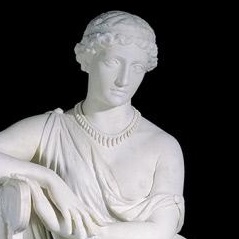Sappho, the famous Greek poet of love, was born around 615 BC on the island of Lesbos. In the few fragments of her work that survive, she wrote passionately and unabashedly about both the emotional and physical feelings of love and desire. Not much else is known about her.
What is certain is that she was widely respected as one of the finest poets of her time, and even today her verses are remarkable for their direct approach to the subject of passionate love. Plato was among her admirers, and is said to have written of her work:
Some say the Muses are nine: how careless! Look, there’s Sappho too, from Lesbos, the tenth.
One thing that sticks to Sappho is the question of her sexuality. Because some of the fragments of Sappho’s love poetry seem to be directed toward another woman, Sappho is often assumed to have been lesbian (and indeed the term “lesbian” derives from Lesbos, Sappho’s island home). She has also been portrayed as a insatiable sexual predator of young men, or as a prostitute. In the nineteenth century there were attempts to clean up the poet’s reputation and scholars claimed that she ran a school for young women. There is a widely circulated story that Sappho threw herself off a cliff for love of a young man named Phaon, but this is also very likely false, and there are scholars who have offered reasons to believe that the poet lived well into middle age. Whatever the true story, this lovely sculpture of the Lesbian poet of love evokes the sadness and languor of unfulfilled love very nicely:
He’s equal with the Gods, that man Who sits across from you, Face to face, close enough, to sip Your voice’s sweetness, And what excites my mind, Your laughter, glittering. So, When I see you, for a moment, My voice goes, My tongue freezes. Fire, Delicate fire, in the flesh. Blind, stunned, the sound Of thunder, in my ears. Shivering with sweat, cold Tremors over the skin, I turn the color of dead grass, And I’m an inch from dying.
–Sappho
Some of the more frankly erotic poems attributed to Sappho in the nineteenth century were, in fact, the work of a French poet named Pierre Louÿs, who, in 1895, penned a spurious collection of erotic poetry by “Bilitis,” a fictional contemporary of Sappho. The works created a stir when they first came out, but were later revealed to be fakes.
Through the years, new fragments of poetry believed to be Sappho’s have turned up from time to time, adding to the precious few that have survived the centuries. As recently as 2012, a new fragment was discovered in the form of a piece of scrap papyrus used to create a type of papier maché in the ancient world.
Here at Crystal Bridges, an elegant marble sculpture of Sappho has been installed in the Colonial to Early Nineteenth-Century Art Gallery, as part of a focus grouping of works that deal with myth and the classics. The sculpture was created by American artist William Wetmore Story, a native of Boston who followed in his father’s footsteps to become a lawyer. His real interests, however, lay in art, music, and literature, and he eventually moved his family to Rome to study sculpture. Story’s representation draws on the legend of Sappho committing suicide for love. The work portrays the poet in a calm, ideal pose. She is seated in a klismos chair, a type of chair from ancient Greece, contemplating her fate, with a wilting rose–a symbol of failed love–drooping across her unstrung lyre.





